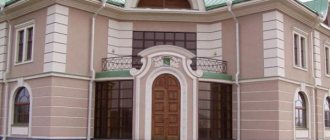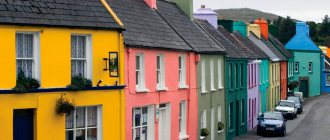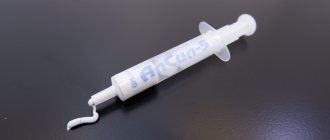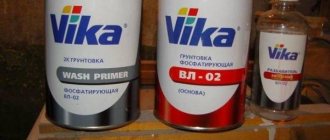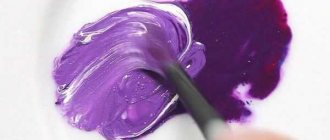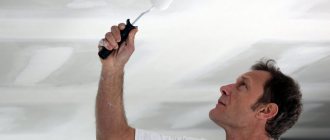What is galvanized steel?
These are steel sheets coated with a thin layer of another metal. The coating is done industrially. This is the so-called anodic coating. Zinc in this case has a lower electrode potential.
Zinc coating provides the surface with multifaceted protection:
• Mechanical – this is insulation from aggressive environmental influences; • Electrochemical - even if the zinc layer is damaged, corrosion will not be able to destroy the steel, since it is a cathode.
When is it necessary to paint galvanized pipes?
One of the reasons for painting galvanized pipes is that under the influence of the sun, air, and water, a thin zinc film loses its qualities over time: it becomes thinner, and pinpoint damage appears. Then the protection becomes unreliable, and the steel quickly rusts.
In addition, the surrounding aggressive environment can damage the zinc itself over time: a white coating forms on it. In such cases, painting extends the service life of rolled metal.
Another reason why additional anti-corrosion protection is required is zinc peeling at welded joints.
It is recommended to paint water-gas pipes (WGP) when they are hot-dip galvanized, i.e. protection is applied on the outside and inside.
Note! If galvanization is present only on the outside, then there is no point in painting, because this is unlikely to extend the service life, since the inner surface of the pipe is still subject to corrosion.
There is no consensus on the need to paint galvanized pipes in an apartment. The homeowner makes the decision himself. If the metal structure disrupts the harmony in the design of the room, or the owner does not like the dull gray color of the pipes, he can paint them in any color.
Is it necessary to paint galvanized metal?
Galvanized steel is protected effectively, but the zinc layer is quite thin - the thickness is about 0.8-2 microns. Over time, under aggressive influences, the zinc itself begins to corrode. So-called “white rust” appears on the surface - a white powder. This rust has an unaesthetic appearance, and the surface of the steel is not protected in any way and is more exposed to adverse effects.
Galvanized metal is often used for roofing as well as other construction work, so it is necessary to paint the surface to protect the steel from corrosion.
What is important to consider when choosing
The production of metal primers is strictly regulated by GOST requirements. In the process of choosing a specific coating, it is recommended to take into account a list of important factors, these are:
- type and characteristics of metal or alloy;
- potential operating conditions (climatic features of the region for outdoor use, temperature conditions and the presence of chemically aggressive fumes when painting indoors);
- scope of use (for household needs or on an industrial scale);
- application technology (manually or using special equipment);
- indicators of adhesion, density, degree of concealment;
- polymerization (drying) time;
- quality and tightness of packaging;
- consumption per 1 sq. meter;
- best before date.
It is very important to consider the degree of damage to the metal surface by corrosion or rust. Correctly selected primer composition and compliance with application rules will allow you to preserve the performance and aesthetic qualities of structures made of different types of metals and alloys for a long time.
Types of paints
Painting galvanized metal, which has a high passivity, is a prerequisite if it is necessary to maximize the service life of the material. When choosing a suitable paint, you need to pay attention to ensure that the coloring material has high elasticity and adhesion characteristics.
Not all paints have sufficient properties for painting galvanized surfaces. For example, oil ones will not work. When applied to metal surfaces, a chemical reaction will begin that will reduce the adhesion and adhesive characteristics of the dye. As a result, after some time the paint will begin to peel off.
The best option is considered to be a choice of coloring compositions for steel and aluminum. These are alkyd, acrylic, vinyl, and rubber paints.
Experts recommend choosing a coloring composition for anodic zinc surfaces that is intended for zinc coating. Despite the fact that primers for galvanized metal and enamel are offered at higher prices, they are not able to provide sufficient protection, but only increase aesthetic characteristics.
Acrylic
Any galvanizing paint has its own technical characteristics, advantages and disadvantages. Acrylic mixtures, which are produced on the basis of organic solvents, have additives that protect against corrosion. After painting and drying, the surface will be matte.
Acrylic dyes are highly resistant to negative atmospheric influences. This is important if the roof is made of metal. Acrylic coatings are resistant to direct sunlight and have a water-repellent effect.
Acrylic paint has good adhesion to metals and a long service life. Along with all this, dyes have affordable prices.
Alkyd
Alkyd paint for galvanized metal is applicable in conditions where a special climate prevails. The composition is also widely used in industry. This enamel is inexpensive, so it is used industrially as a paint for galvanized pipes and other metal structures.
Alkyd enamels form a glossy surface after drying. The paint contains anti-corrosion pigments and has high performance characteristics. However, as with oil paints, they react with the zinc layer and damage its structure.
Vinyl enamels
These dyes are not inferior in resistance to adverse weather conditions. These enamels are highly durable and can withstand high temperatures. Zinc coating is durable and has high elasticity characteristics. The only negative is the cost of the paint.
The paint is made on an acrylic base, and when dry it forms a durable protective layer reminiscent of rubber. An important advantage is protection from mechanical damage.
Why is it important to use primers?
One of the main problems with the failure of metal products or structures is the formation and rapid spread of corrosion (as a result of exposure to moisture or chemical reagents). Preliminary application of primer compositions allows:
- improve the protective characteristics of paints, varnishes, enamels;
- remove dust from the metal surface;
- increase adhesion (the ability to reliably set) between metals and coloring compounds;
- improve aesthetic qualities (protective coatings lie on the ground tightly, evenly, without smudges or defects);
- reduce the consumption of enamels and paints, and therefore the cost of painting work.
The use of primers before finishing allows you to create reliable protection of metals from corrosion and rust, which leads to an increase in the service life of varnish, paint, and enamel coatings.
Special coloring compounds
As you can see, all of the above options have certain disadvantages when working with galvanized surfaces. On the modern market there are special paints developed specifically for galvanized steel.
The best option is to use acrylic primers for galvanizing. It is both a protective primer and an enamel. The price of such a coating is higher, but the level of protection of the painted surface is much better, while the aesthetic characteristics are also excellent.
Imported paints
The most popular galvanizing paints for exterior use are roofing brands such as Hammerite and Tikkurilla. The first product is good because it can be applied even to surfaces damaged by corrosion.
Among the main advantages are:
• wear-resistant and durable coating; • high adhesion to metals; • anti-corrosion protection; • aesthetics; • drying speed; • number of available colors; • resistance to ultraviolet radiation.
Disadvantages include salt deposits that form over time, corrosion after just a few years, cracking due to insufficient degreasing, and air bubbles when applied to a metal surface with a roller.
The option from the Finnish manufacturer Tikkurilla has more advantages - it is epoxy paint and at the same time a primer for metal. Here, in addition to the above properties: a high level of resistance to weathering and chemical influences, heat resistance, the ability to be stored at low temperatures, and the ability to apply paint yourself.
The manufacturer recommends applying the coating in relatively hot weather. Hot metal promotes better adhesion.
On video: paint for metal structures from Tikkuril.
Domestic products
Along with imported materials, no less high-quality domestic products are also on sale. The most popular option is Tsikrol paint. This is a special acrylic paint composition that is designed to work with galvanized surfaces. It is based on acrylic resins with additives from polymers and organic solvents.
The material is characterized by many advantages:
• high adhesion to the surface; • high hiding power; • high level of anti-corrosion protection; • high resistance to moisture; • resistance to sunlight; • quick drying.
You can use this paint on roofs made of galvanized sheets, corrugated sheets, and tin. This composition is widely used for galvanized pipes and other structures, rolled metal.
You can apply Tsikrol paint without mandatory priming; a single layer application is sufficient.
The best choice
Galvanized and rust enamel has gained particular popularity among consumers who are guided by the above criteria when choosing a paint coating. This type of paint and varnish coating provides a significant extension of the service life of any structures made of galvanized metal (roofing, pipes). The cost of primer enamel exceeds the price of conventional paints. However, the result obtained after painting is worth the investment.
Alkyd primer-enamel from “Hammerite” attracts with its high adhesive properties, the ability to create a durable coating and ensure a good appearance of the painted structure. In addition, this enamel primer is applied directly over rust, dries quickly and is not affected by ultraviolet rays. Additional advantages include a wide range of colors.
Of course, Hammerite enamel is not a panacea. Among the disadvantages is the demanding choice of painting methods (for example, when applied with a roller, air bubbles may form). In addition, insufficient degreasing of the surface leads to cracking, rust forms approximately in the third year after painting, and salt deposits appear even earlier.
Epoxy paint “Tikkurila” has a less capricious character. Withstands aggressive influences from atmospheric agents and chemicals, and can withstand temperatures reaching +80°C.
It is important for domestic consumers that epoxy paint from Tikkurila can be transported and stored even at severe sub-zero temperatures. The only whim is that painting should be done in the hot season, since in this case the adhesion of the paint to the heated galvanized metal will be much better.
The necessary fire safety will be ensured by covering the galvanization with fire-retardant paint for metal “Polistil”. This paint perfectly protects structures in the event of a fire and is quite affordable in cost.
If you need to increase the level of protection, it is best to use Zinga electrically conductive paint. This coating is an analogue of industrial hot-dip galvanizing due to its composition of 96% zinc. The impression of high anti-corrosion properties and the absence of difficulties in operation can slightly spoil the cost. But if you need good protection, you don’t have to think about the price.
How to paint galvanized metal
For a quality result, it is important not only to choose the right paint, but also to know how to paint. First of all, the preparatory work is carried out:
• remove old paint; • remove dirt; • the surface is washed; • degrease; • dried; • repair defects.
Then you need to paint the galvanized metal. Paint on galvanized iron is applied with brushes, rollers or spray guns. Acrylic primer enamels can be applied in 2-3 layers. Efficiency can be increased by using several primer compositions.
First, before painting, apply the first composition, then after complete drying the second. The primer is applied with a lint roller. Then a primer with anti-corrosion characteristics is applied. After this, you can apply primer-enamel.
Tips for painting metal and choosing paint (2 videos)
Products of different brands (35 photos)
Coloring technology - step-by-step instructions
The general procedure for applying paint, as well as working conditions with the material, are indicated on the packaging with the composition. These recommendations must be taken into account when processing galvanized iron.
Preparatory work
Before painting, galvanized iron must be degreased using solvents and cleaned of contaminants. It is recommended to keep the material in the fresh air for 24 hours. In this case, the metal will absorb oxygen, which will have a positive effect on the adhesion of zinc.
Also, to improve this property, it is recommended to treat the surface with abrasive compounds or a primer, using products from the same company as the paint.
Creating a protective layer
It is also recommended to treat the metal with an alkaline detergent before painting. The latter will remove remaining contaminants and create an additional protective layer.
Painting
The paint must be thoroughly stirred before use. If this is indicated in the instructions, then the appropriate solvent must be added to this composition. Painting is carried out using a brush or roller. If large surface areas are being treated, it is recommended to carry out the procedure using a sprayer. The number of layers that need to be applied to the metal is indicated in the instructions (minimum 2). To achieve a rich paint color, this procedure can be carried out 3 or more times.
Why is galvanized painted?
Despite the high level of protection, galvanizing is subject to corrosion over time, traces of which appear on the coating after several years and look like a white powdery substance. Corrosion of galvanized metal is called “white rust”. To prevent it from appearing, it is necessary to apply a layer of special paint and varnish material to the surface, thanks to which the service life of the structure or product will be significantly extended.
In addition, galvanizing paint makes the material more attractive and presentable. The beautiful appearance of metal is especially important when it is used for the roofing of a house, or for any part or structure that is visible to many people. Therefore, we can say with complete confidence that painting galvanized steel is a very useful and important procedure.
